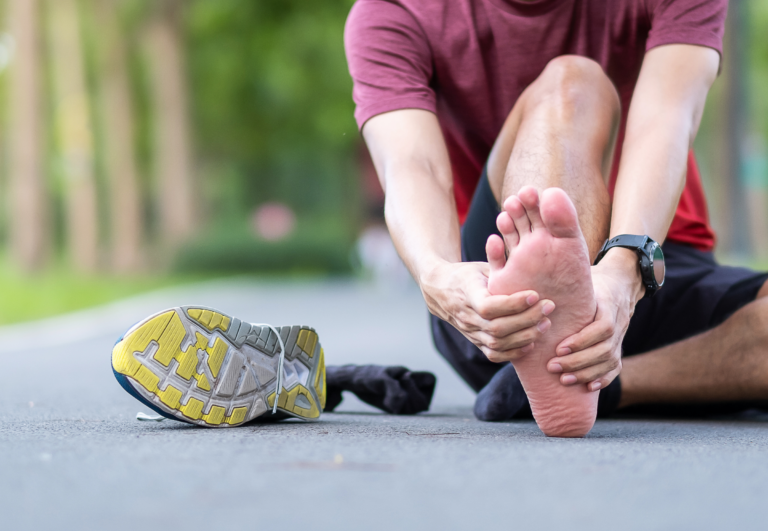The Runner’s Cold Weather Skincare Guide: A 7-Step System To Protect Your Skin!
While the crisp winter air can be invigorating, it’s also deceptively damaging to our skin, which can suffer from dryness, chapping, and irritation during these colder months. This is why a tailored skincare routine is as crucial as a good pair of running shoes for those who love to pound the pavement year-round.
But it’s not just about comfort; it’s about health. The skin is our largest organ and serves as the first line of defense against environmental elements. Keeping it in top condition ensures that it can continue to protect us effectively. So, let’s lace up our shoes and delve into the world of cold weather skincare with a guide that’s as practical as it is protective, ensuring your skin stays as resilient as your spirit.
Understanding Your Skin’s Needs in Cold Weather
When temperatures drop, the humidity level often plummets as well. This lack of moisture in the air can lead to dehydrated skin, which not only feels tight and uncomfortable but can also become flaky and inflamed.
Moreover, cold weather can constrict blood vessels, which reduces blood flow and, consequently, the amount of oxygen and nutrients your skin receives. This can impair the skin’s ability to repair itself and maintain a healthy barrier against the cold.
But it’s not just the cold air that’s a concern; the winter sun can be just as damaging as the summer sun. UV rays can penetrate clouds and even reflect off snow, leading to potential sunburn and long-term skin damage. This is why a comprehensive skincare strategy is essential for runners braving the cold, focusing on protection, hydration, and repair.
Step 1: Pre-Run Protection
Before you set foot outside, your skincare routine begins. The goal here is to create a shield between your skin and the chilly environment.
Start with a gentle cleanser to remove any impurities or oils that could hinder the effectiveness of your moisturizer. Then, apply a high-quality moisturizer. Look for ingredients like hyaluronic acid, which can hold up to 1000 times its weight in water, ensuring your skin stays hydrated even in the driest conditions.
Don’t forget to apply a broad-spectrum sunscreen with at least SPF 30 to all exposed areas. UV rays don’t take a winter break, and neither should your sun protection.
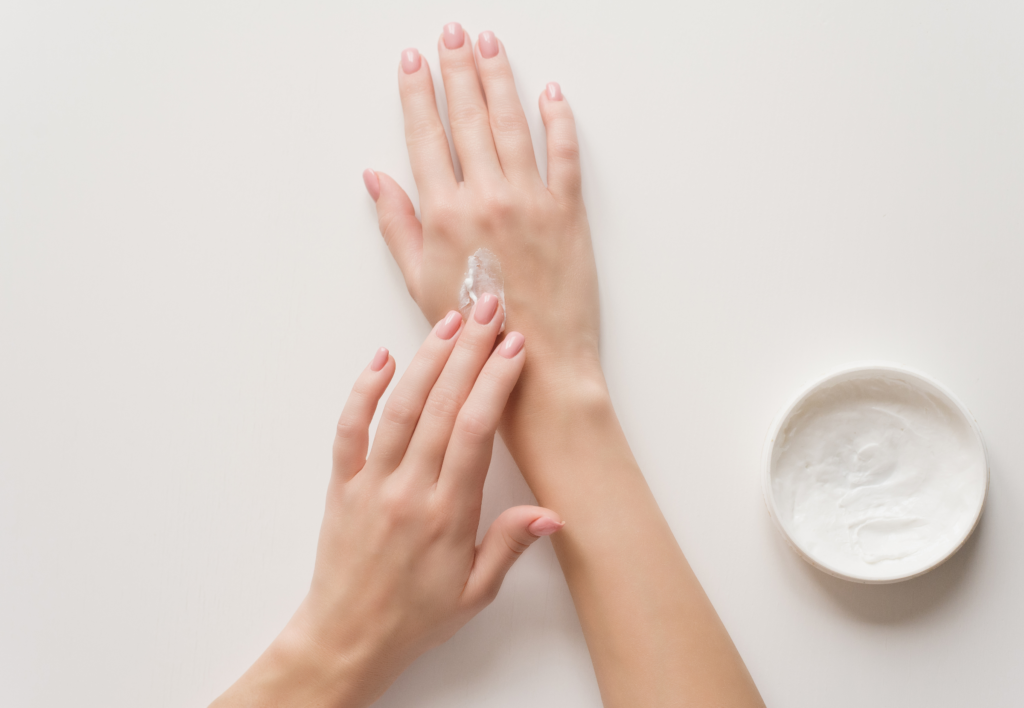
Actionable Tips:
- Use lukewarm water when washing your face to prevent stripping away natural oils.
- Choose a moisturizer that’s right for your skin type; runners with oily skin might prefer a gel-based product, while those with dry skin may need a richer cream.
- Apply sunscreen 15 minutes before you head out, giving it time to absorb into your skin.
- Don’t neglect your hands and neck, which are often exposed and forgotten in skincare routines.
Step 2: Dressing for Success
Your choice of attire plays a significant role in protecting your skin. The key is to layer up.
Start with a moisture-wicking base layer that keeps sweat away from your skin, as damp skin can become even more irritated in the cold. Add an insulating layer for warmth and top it off with a wind- and water-resistant shell to protect against the elements.
For your face, consider a balaclava or a high-neck gaiter that you can pull up when the wind bites. And always wear gloves or mittens to shield your hands from the cold and drying effects of the wind.
Actionable Tips:
- Invest in technical fabrics specifically designed for cold weather running; avoid cotton as it holds moisture.
- Use a scarf or neck gaiter made of soft, non-irritating fabric to cover your face when needed.
- Opt for gloves with touchscreen capability so you can manage your devices without exposing your skin.
- Choose socks that wick away moisture to prevent blisters and keep your feet dry and warm.
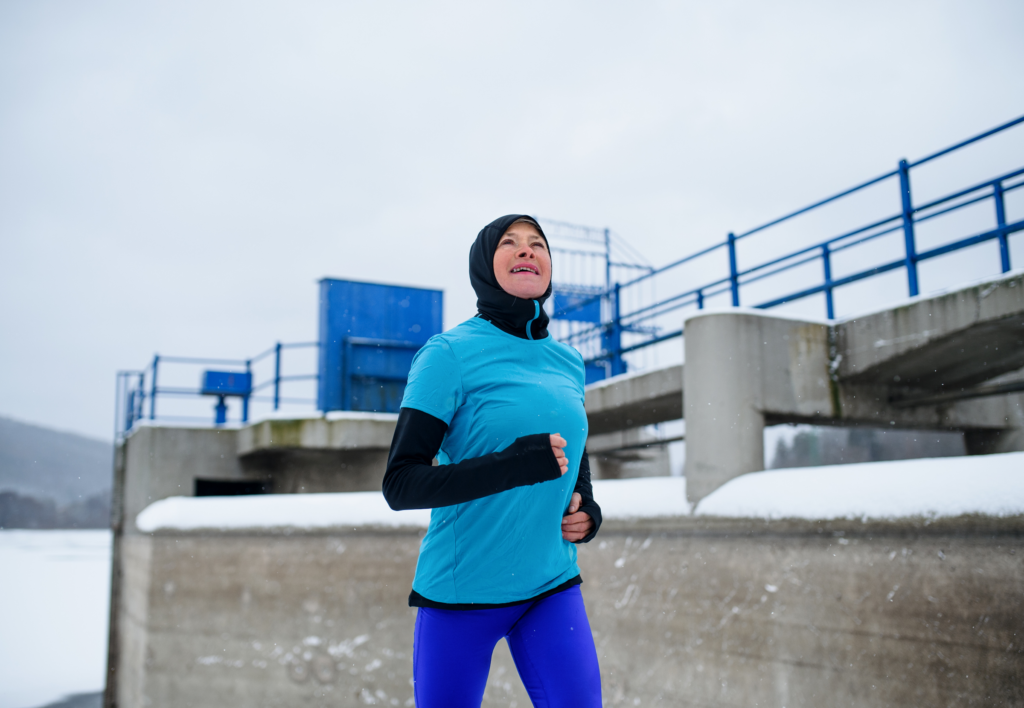
Step 3: Moisturize, Moisturize, Moisturize
Hydration is your skin’s best friend, especially in the winter months. After you’ve layered up and before you step outside, it’s crucial to apply a thick, emollient moisturizer to any exposed skin. This creates a physical barrier that locks in moisture and protects against the biting cold and wind.
For the best results, look for moisturizers that contain ceramides, which support the skin’s natural barrier, and glycerin or dimethicone, which provide a protective seal over the skin.
Actionable Tips:
- Reapply moisturizer to your face and hands immediately after washing or sanitizing them.
- If you’re going for a long run, consider carrying a small travel-sized moisturizer to reapply, especially if you tend to sweat or if the weather is particularly harsh.
- Don’t forget to apply a hydrating eye cream; the skin around your eyes is delicate and prone to drying out in cold weather.
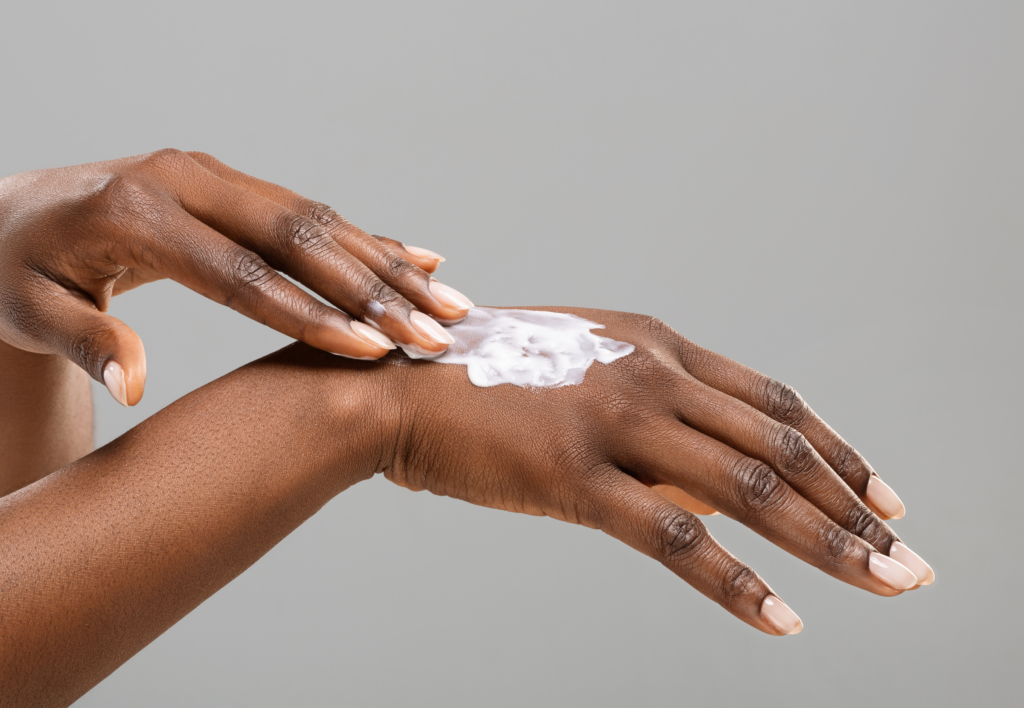
Step 4: Lip Care Is Essential
Your lips are one of the most exposed parts of your body and often the first to show signs of cold weather damage. Chapped lips are not only uncomfortable but can also lead to cracking and bleeding, which is why they need special attention. Use a lip balm with SPF to protect against UV rays, and reapply frequently. Look for ingredients like beeswax, shea butter, or petroleum, which provide a protective layer and help to lock in moisture.
Actionable Tips:
- Keep a lip balm in your running jacket or hydration pack so you can easily reapply as needed.
- Avoid licking your lips, as this can remove the protective balm and the natural oils, leading to further drying.
- If your lips are already chapped, use a gentle lip scrub once a week to remove dead skin cells and follow with an intensive overnight lip treatment.
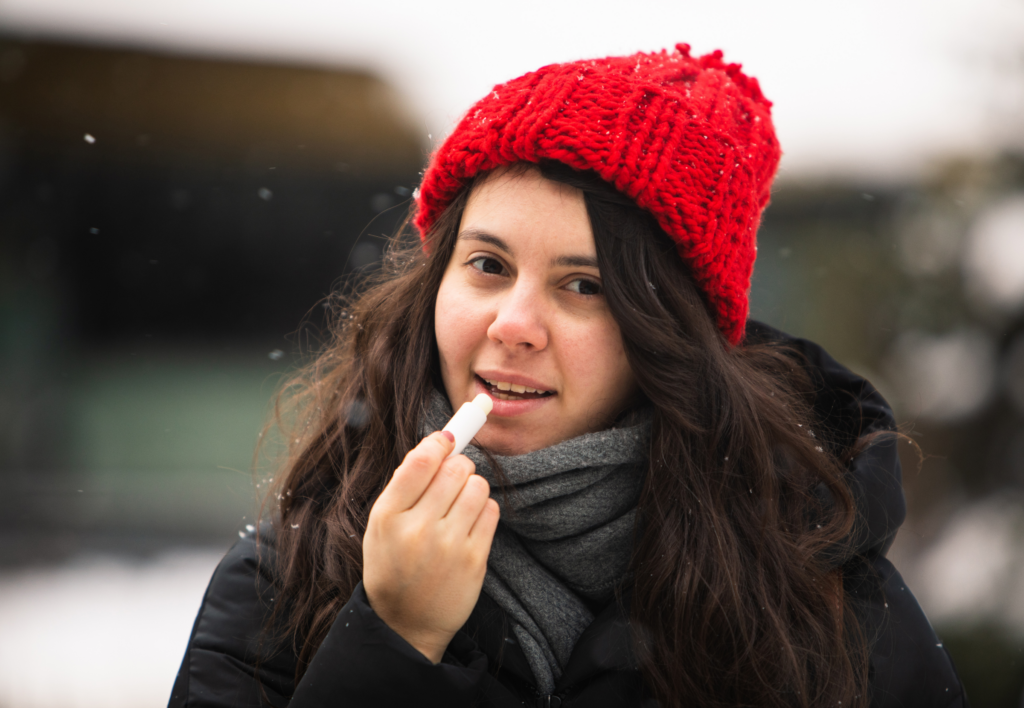
Step 5: Post-Run Recovery for Your Skin
After a cold run, your skin needs to recover from exposure to harsh conditions. Begin your post-run routine with a short, lukewarm shower to wash away sweat and any pollutants. Avoid hot water, which can strip your skin of its natural oils. After showering, pat your skin dry gently—don’t rub vigorously, as this can lead to irritation.
Apply a post-run moisturizer while your skin is still damp to lock in moisture. This time, you might want to use a product with restorative ingredients like vitamin E, aloe vera, or hyaluronic acid to help soothe and repair your skin.
If you notice any redness or windburn, a product with anti-inflammatory properties, such as those containing niacinamide or colloidal oatmeal, can help calm the skin.
Actionable Tips:
- Consider using a richer, more hydrating moisturizer than the one you used pre-run, as your skin will need extra help to recover.
- If you have dry or cracked skin, apply a healing ointment to those areas to promote healing.
- Remember to extend your skincare routine to include your body, not just your face. Areas like your legs and arms also need hydration after being exposed to the cold.
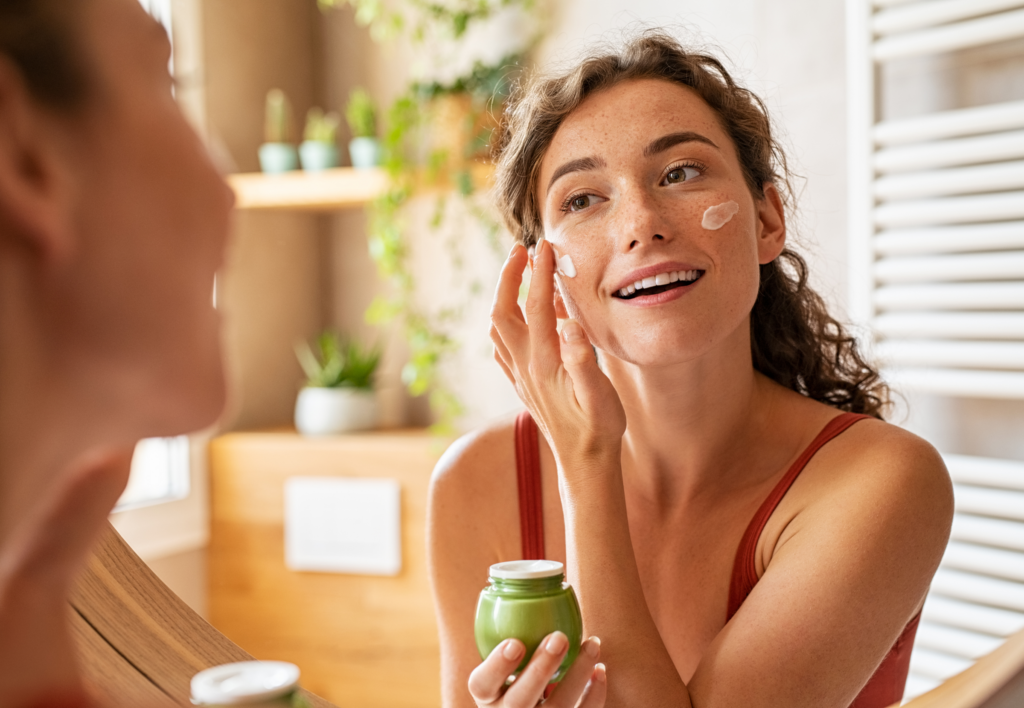
Step 6: Hydration From the Inside Out
While topical treatments are important, true hydration begins from within. Drinking enough water before, during, and after your run is crucial for maintaining healthy skin. Cold weather can be deceptive; you might not feel as thirsty as you do in hot weather, but your body still loses fluids through sweat and respiration.
In addition to water, consider consuming foods high in omega-3 fatty acids, such as salmon, flaxseeds, and walnuts, which can help keep your skin supple. Foods rich in antioxidants, like berries and leafy greens, can protect your skin from environmental damage.
Actionable Tips:
- Carry a water bottle with you throughout the day to remind yourself to drink regularly.
- Set hydration goals for yourself, especially on run days, to ensure you’re replacing the fluids you lose.
- Consider using a humidifier in your home, especially if you use central heating, which can dry out the air and, in turn, your skin.

Step 7: Nighttime Skincare
Nighttime is when your body, including your skin, goes into repair mode. Capitalize on this natural recovery process by adopting a nighttime skincare routine that supports the healing and strengthening of your skin.
After cleansing away the day’s dirt and grime, use a richer, more nourishing moisturizer or a night cream that’s packed with regenerative ingredients like peptides, retinol, or antioxidants. These ingredients can help boost collagen production, repair any damage from the day’s exposure, and replenish moisture.
If you’ve faced particularly harsh conditions, or if you’re noticing dry patches or redness, consider applying a hydrating serum or face oil before your moisturizer for an extra hydration boost. For your hands and feet, which may get neglected during your daytime routine, slather on a thick cream or ointment and cover them with cotton gloves and socks to lock in moisture overnight.
Actionable Tips:
- Apply your nighttime products at least an hour before bed to ensure they’re absorbed and don’t rub off on your pillow.
- Use an overnight hydrating mask once or twice a week for an extra moisture surge.
- Don’t forget about your neck and décolletage, which can also show signs of aging and weather exposure.
Common Mistakes to Avoid
Even with the best intentions, runners can sometimes make skincare mistakes that compromise their skin’s health, especially in winter.
Here are some common pitfalls to avoid:
- Skipping Sunscreen on Cloudy Days: UV rays can penetrate clouds and cause damage. Always apply sunscreen, no matter the weather.
- Neglecting Humidity: Indoor heating can dry out your skin. Use a humidifier to add moisture back into the air.
- Using Harsh Cleansers: Avoid products that strip your skin of its natural oils. Opt for gentle, hydrating cleansers instead.
- Over-Exfoliating: While exfoliation is important, doing it too often or using harsh scrubs can damage your skin’s barrier.
- Ignoring Your Neck and Hands: These areas can show signs of aging and damage just like your face, so include them in your skincare routine.
By avoiding these mistakes and following the outlined steps, you can keep your skin protected, hydrated, and healthy throughout the cold months. Your skin is your ally as a runner, and taking care of it ensures that you can continue to enjoy your runs, no matter what the winter weather brings.


